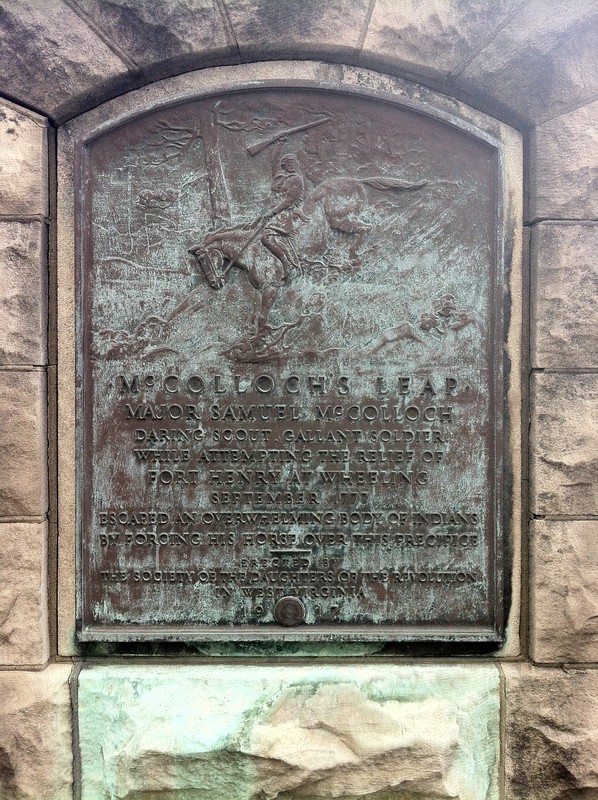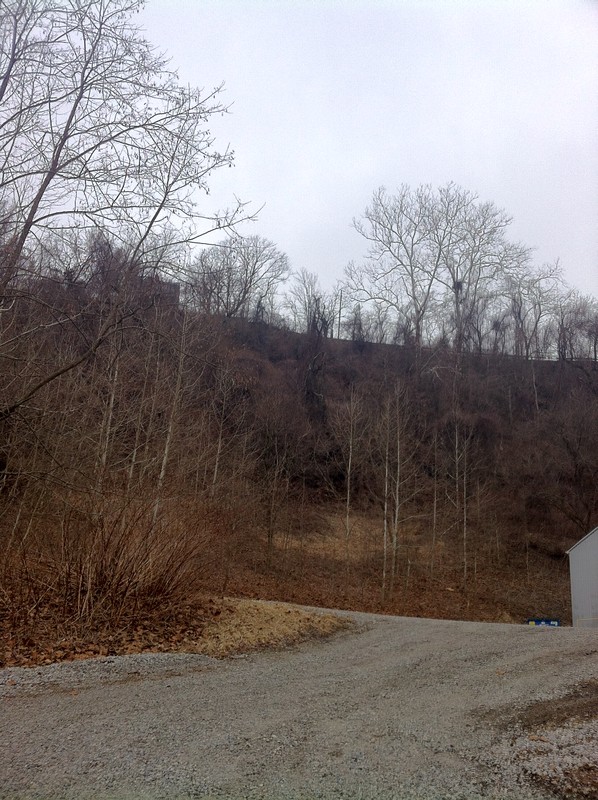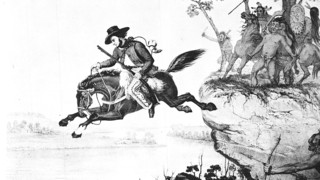McCulloch's Leap
Introduction
Text-to-speech Audio
Samuel McCulloch and his family moved from New Jersey to the area that is now Wheeling, WV in 1770. He went on to become the commander of Van Meter’s Fort, a member of the Virginia Legislature, and a major in the local militia. McCulloch rushed to help Fort Henry when it was under attack on September 2nd, 1777, but was cut off by Native Americans. To escape the Native Americans, it is said that McCulloch and his horse leaped from the ledge on the top of Wheeling Hill, and survived.
Images
Looking at the monument

Looking from the bottom of Wheeling Hill up to the monument

Depiction of McCulloch's Leap.

Backstory and Context
Text-to-speech Audio
Lord Dunmore's War began in 1774, after the land of the Shawnee was slowly being taken away from them. The massacre of the Logan family, a Mingo group living and trading with settlers at the mouth of Yellow Creek near Steubenville, Ohio, was the tipping point for the Shawnee. The issues at stake in the conflict on the frontier from 1774 to 1795 were ones of land ownership and control of trade routes. Lord Dunmore's War worried the settlers, and they built Fort Henry for protection. The first attack on Fort Henry started on September 1st, 1777, and lasted for three days and three nights. Fort Henry was defended by 60 men, and almost half of them were lured out of the fort and killed by the 200 Wyandots and Mingos. Messengers were sent out to local forts and militias to request aid during this time, and McCulloch and his men went as soon as they received word.
On September 2nd, 1777, as McCulloch and his men were in route to Fort Henry, McCulloch was cut off by Native Americans and separated from his men. McCulloch was well known by the Native Americans for his heavy involvement in battles, and for killing many of their own. Once McCulloch was cut off, he directed his horse towards Wheeling Hill, as it was his only means of escape. Two other groups of Native Americans cut him off, and McCulloch's only route of escape was to jump over a one hundred and fifty foot ledge that led to Wheeling Creek.
On September 2nd, 1777, as McCulloch and his men were in route to Fort Henry, McCulloch was cut off by Native Americans and separated from his men. McCulloch was well known by the Native Americans for his heavy involvement in battles, and for killing many of their own. Once McCulloch was cut off, he directed his horse towards Wheeling Hill, as it was his only means of escape. Two other groups of Native Americans cut him off, and McCulloch's only route of escape was to jump over a one hundred and fifty foot ledge that led to Wheeling Creek.
"McCulloch still bore his rifle, which he had retained, in his right hand, and carefully gathering up the bridle in his left, he urged his noble animal forward, encouraging him by his voice, until they reached the edge of the bank, when, dashing his heels against his sides, they made the fearful leap into the air."1McCulloch and his horse slid and scrambled down the ledge of the hill, and landed at the river bank with extremely minor injuries. He then rushed to his home fort, gathered a force of 40 men, and returned to Fort Henry only to find that the Native Americans had already retreated across the Ohio River. However, the truth about McCulloch's Leap has been heavily disputed among historians. There is little documentation of Samual McCulloch prior to 1777, and most documented information. though sparse, is only about his leap.
This deed is, unfortunately, not recorded in any documented report of the attack, or in accounts later related to historians. Nor does anyone record whether the leap took place at this time. Layman C. Draper believed that the leap occurred, but not as part of this siege. The leap is part of the history of this area, and, with the information we have about McColloch, seems to fit with recorded statements of his bravery. But, more factual information is not extant.2Whether or not McCulloch's leap was as dramatic or extravagant as folklore leads us to believe, it gives insight to battle tactics of both sides from the war. McCulloch later lost his arm in a hunting accident, and later died at the hands of Native Americans in 1782. There is a monument dedicated to his bravery and escape from the Native Americans on September 2nd, 1777.
Sources
1. "McColloch's Leap." Wheeling History. Accessed October 25, 2016. http://www.ohiocountylibrary.org/wheeling-history/4295.
2. "PART TWO: Biography of Samuel McColloch -- Did Major Really Leap?" Wheeling History. Accessed October 25, 2016.
http://www.ohiocountylibrary.org/wheeling-history/4298#Part1
3. "Share McColloch's Leap." E-WV. Accessed October 25, 2016. http://www.wvencyclopedia.org/articles/1617.
